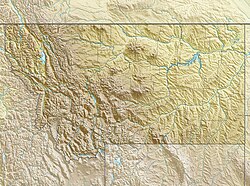Blackleaf Formation
| Blackleaf Formation | |
|---|---|
| Stratigraphic range: late Albian-Cenomanian ~ | |
| Type | Formation |
| Unit of | Colorado Group |
| Lithology | |
| Primary | Mudstone, sandstone |
| Other | Shale, siltstone |
| Location | |
| Coordinates | 44°30′N 112°36′W / 44.5°N 112.6°W |
| Approximate paleocoordinates | 45°54′N 72°18′W / 45.9°N 72.3°W |
| Region | |
| Country | |
The Blackleaf Formation is a geologic formation in Montana. It preserves fossils dating back to the Albian to Cenomanian stages of the Cretaceous period.[1]
Description
[edit]The formation comprises an isolated, sinuous sandstone body sitting within and crosscutting a succession of three mudrock units. The lowermost mudstone is greater than 35 cm in thickness, light greenish grey and weakly calcareous. This unit exhibits extensive dark reddish grey mottling over its uppermost portion. Additionally, carbonate nodules as much as 4.5 cm in diameter form a discontinuous layer of 20–25 cm below the sharp upper contact of the unit. A dark greenish-grey claystone succeeds vertically. This 25 cm thick unit is calcareous with a platy structure and grades upwards into a greenish grey blocky mudstone with some organics. This third unit encloses the upper portion of the sedimentary structure and bears a sharp, irregular contact with an overlying burrowed dark red claystone. The lithology of the structure contrasts sharply with the surrounding host mudrock and facilitates recognition of the structure in the field.[2]
The lower, bone-bearing portion consists of 25–30 cm of medium to fine, calcareous greenish-grey sandstone, moderately sorted with abundant plagioclase and other volcanogenic grains. Small (3–6 mm), rounded mud clasts are common in the coarser basal portion. This structureless unit fines upwards with an increasing clay content. A thin, 1–2 cm thick, grey claystone separates this lower sand- stone from an upper fine sandstone. The bedding parallels that of the host mudrocks. Reduced clay content, grey colour and larger (approx. 10 mm), platy mud clasts distinguish this unit from the otherwise similar, lower sandstone. A thin (less than 1 cm) rim of tan claystone with abundant calcite veins separates the lower portion of the structure from the host mudrocks.[2]
Fossil content
[edit]The following fossils were reported from the formation:[1]
- Reptiles
- Oryctodromeus cubicularis[3]
- Bernissartia sp.[4]
- Glyptops sp.[4]
- Ankylosauridae indet.[4]
- Chelydridae indet.[4]
- Dromaeosauridae indet.[4]
- Goniopholididae indet.[4]
- Hadrosauridae indet.[4]
- Testudines indet.[4]
- Tyrannosauridae indet.[4]
- Fish
- Flora
- Araliaephyllum westonii[5]
- cf. Aralia wellingtonia[5]
- Araliopsoides cf. cretacea[5]
- cf. Aspidophyllum trilobatum[5]
- cf. Ficus ovatifolia[5]
- cf. Celastrophyllum sp.[5]
- Cinnamomoides sp.[5]
- Nymphaeites sp.[5]
- Platanophyllum sp.[5]
- cf. Protophyllum sp.[5]
See also
[edit]References
[edit]Bibliography
[edit]- Ullmann, P. V.; Varricchio, D.; Knell, M. J. (2012), "Taphonomy and taxonomy of a vertebrate microsite in the mid-Cretaceous (Albian–Cenomanian) Blackleaf Formation, southwest Montana", Historical Biology, 24: 311–328
- Varricchio, D. J.; Martin, A. J.; Katsura, Y. (2007), "First trace and body fossil evidence of a burrowing, denning dinosaur", Proceedings of the Royal Society of London B, 274 (1616): 1361–1368, doi:10.1098/rspb.2006.0443, PMC 2176205, PMID 17374596
- Crabtree, D. R (1987), "Angiosperms of the Northern Rocky Mountains: Albian to Campanian (Cretaceous) megafossil floras", Annals of the Missouri Botanical Garden, 74 (4): 707–747, doi:10.2307/2399448, JSTOR 2399448
- Pages using the JsonConfig extension
- Geologic formations of Montana
- Cretaceous System of North America
- Cretaceous Montana
- Albian Stage
- Cenomanian Stage
- Mudstone formations
- Sandstone formations
- Shale formations
- Siltstone formations
- Deltaic deposits
- Fluvial deposits
- Lacustrine deposits
- Ooliferous formations
- Paleontology in Montana


